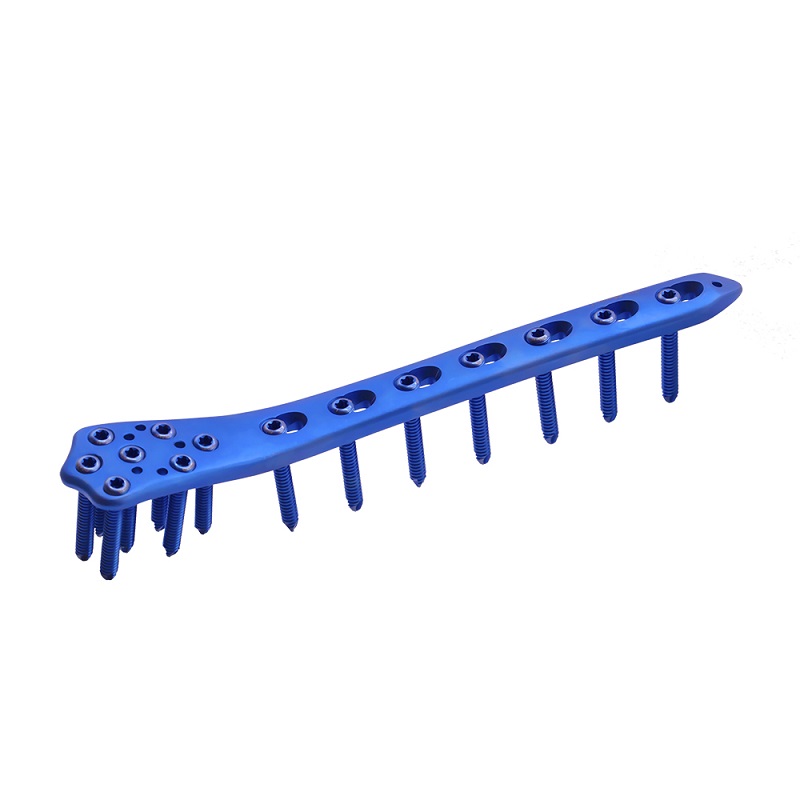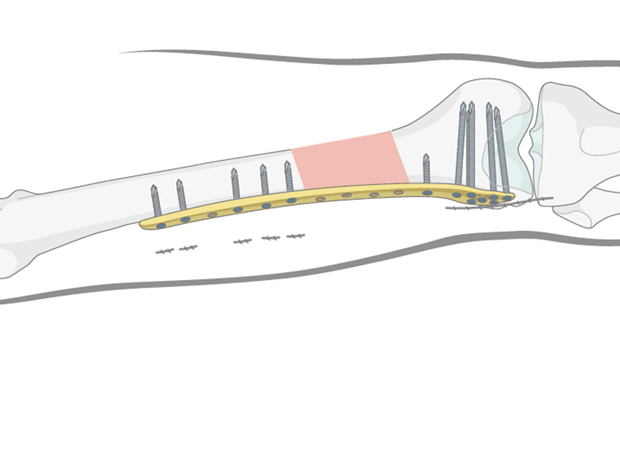Introduction
The medical field is continually evolving, with innovations that enhance patient outcomes and surgical procedures. Among these innovations, the Distal Femoral Locking Plate stands out as a crucial tool in orthopedic surgery. In this extensive guide, we will delve into the world of Distal Femoral Locking Plates, exploring their applications, advantages, and answering common questions surrounding this vital medical device.
Distal Femoral Locking Plate: A Game-Changer in Orthopedic Surgery
Orthopedic surgeons have long sought advanced solutions for treating complex fractures of the distal femur. The Distal Femoral Locking Plate, a marvel of modern orthopedics, has revolutionized the management of such fractures.
Understanding the Distal Femoral Locking Plate
The Distal Femoral Locking Plate, often abbreviated as DFLP, is a specialized implant used in orthopedic surgery. It is designed to provide stability and support to the distal (lower) part of the femur, making it an indispensable tool for managing fractures in this region.

Applications of the Distal Femoral Locking Plate
Treating Distal Femur Fractures
One of the primary applications of the Distal Femoral Locking Plate is in the treatment of distal femur fractures. These fractures are challenging to manage due to the complex anatomy of the distal femur. The DFLP's design allows for secure fixation, promoting faster healing and better outcomes.
Correcting Deformities
In addition to fractures, the DFLP can be used to correct deformities of the distal femur. This is particularly important in cases of malunion or nonunion, where the bone has healed improperly or not at all.
Total Knee Arthroplasty
The Distal Femoral Locking Plate also plays a critical role in total knee arthroplasty, providing stability and support to the knee joint during the surgical procedure.

Advantages of Using a Distal Femoral Locking Plate
The Distal Femoral Locking Plate offers several advantages that make it a preferred choice for orthopedic surgeons:
Enhanced Stability: The plate's locking screws provide exceptional stability, reducing the risk of implant failure and promoting proper bone healing.
Anatomical Design: DFLPs are designed to closely match the natural anatomy of the distal femur, ensuring a precise fit and optimal support.
Minimal Invasive: Surgeons can often perform DFLP surgeries with minimally invasive techniques, leading to smaller incisions, less pain, and quicker recovery times for patients.
Versatility: These plates come in various sizes and configurations, allowing surgeons to choose the most suitable option for each patient's unique needs.
Reduced Complications: The use of locking screws reduces the risk of complications like screw loosening and implant migration.
Frequently Asked Questions (FAQs)
Q: How is the Distal Femoral Locking Plate different from traditional plates?
Traditional plates rely on compression between the bone fragments for stability. In contrast, the Distal Femoral Locking Plate uses locking screws to provide absolute stability, reducing the risk of implant failure.
Q: Is the Distal Femoral Locking Platedddddd suitable for all patients?
While the DFLP is a versatile implant, its suitability depends on the patient's specific condition. Your orthopedic surgeon will assess your case and determine if it's the right choice for you.
Q: What is the recovery like after a Distal Femoral Locking Plate surgery?
Recovery varies from patient to patient, but the use of DFLPs often allows for quicker rehabilitation and earlier return to normal activities compared to traditional methods.
Q: Are there any risks associated with using a Distal Femoral Locking Plate?
As with any surgical procedure, there are risks involved. These may include infection, implant loosening, or nonunion. However, the use of DFLPs has significantly reduced these risks compared to traditional treatments.
Q: How long does it take to perform a surgery using a Distal Femoral Locking Plate?
The duration of surgery depends on the complexity of the fracture or deformity being treated. On average, it can take anywhere from one to three hours.
Q: Are there any non-surgical alternatives to using a Distal Femoral Locking Plate?
In some cases, non-surgical treatments like casting or traction may be considered. However, these are typically reserved for less severe fractures or when surgery is not feasible.
Conclusion
The Distal Femoral Locking Plate is a remarkable advancement in orthopedic surgery, offering enhanced stability, precise anatomical fit, and versatility in treating distal femur fractures and deformities. Its use has significantly improved patient outcomes and reduced the risk of complications. If you or a loved one are facing such orthopedic challenges, consult with a qualified orthopedic surgeon to explore the potential benefits of the Distal Femoral Locking Plate.
How to Buy Orthopaedic Implants and Orthopaedic Instruments?
For CZMEDITECH, we have a very complete product line of orthopedic surgery implants and corresponding instruments, the products including spine implants, intramedullary nails, trauma plate, locking plate, cranial-maxillofacial, prosthesis, power tools, external fixators, arthroscopy, veterinary care and their supporting instrument sets.
In addition, we are committed to continuously developing new products and expanding product lines, so as to meet the surgical needs of more doctors and patients, and also make our company more competitive in the whole global orthopedic implants and instruments industry.
We export worldwide, so you can contact us at email address song@orthopedic-china.com for a free quote, or send a message on WhatsApp for a quick response +86-18112515727.
English
Français
Русский
Español
العربية
Português
Deutsch
italiano
日本語
한국어
Nederlands
Tiếng Việt
ไทย
Polski
Türkçe
አማርኛ
ພາສາລາວ
ភាសាខ្មែរ
Bahasa Melayu
ဗမာစာ
தமிழ்
Filipino
Bahasa Indonesia
magyar
Română
Čeština
Монгол
қазақ
Српски
हिन्दी
فارسی
Kiswahili
Slovenčina
Slovenščina
Norsk
Svenska
українська
Ελληνικά
Suomi
Հայերեն
עברית
Latine
Dansk
اردو
Shqip
বাংলা
Hrvatski
Afrikaans
Gaeilge
Eesti keel
Māori
नेपाली
Oʻzbekcha
latviešu
অসমীয়া
Aymara
Azərbaycan dili
Bamanankan
Euskara
Беларуская мова
भोजपुरी
Bosanski
Български
Català
Cebuano
Corsu
ދިވެހި
डोग्रिड ने दी
Esperanto
Eʋegbe
Frysk
Galego
ქართული
guarani
ગુજરાતી
Kreyòl ayisyen
Hausa
ʻŌlelo Hawaiʻi
Hmoob
íslenska
Igbo
Ilocano
Basa Jawa
ಕನ್ನಡ
Kinyarwanda
गोंगेन हें नांव
Krio we dɛn kɔl Krio
Kurdî
Kurdî
Кыргызча
Lingala
Lietuvių
Oluganda
Lëtzebuergesch
Македонски
मैथिली
Malagasy
മലയാളം
Malti
मराठी
ꯃꯦꯇꯥꯏ (ꯃꯅꯤꯄꯨꯔꯤ) ꯴.
Mizo tawng
Chichewa
ଓଡ଼ିଆ
Afaan Oromoo
پښتو
ਪੰਜਾਬੀ
Runasimi
Gagana Samoa
संस्कृत
Gaelo Albannach
Sepeti
Sesotho
chiShona
سنڌي
Soomaali
Basa Sunda
Wikang Tagalog
Тоҷикӣ
Татарча
తెలుగు
ትግንያውያን
Xitsonga
Türkmençe
संस्कृत
ئۇيغۇرچە
Cymraeg
isiXhosa
ייִדיש
Yorùbá
isiZulu












